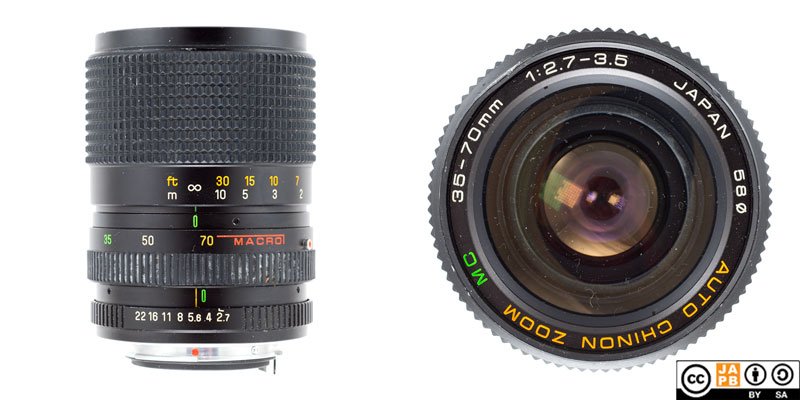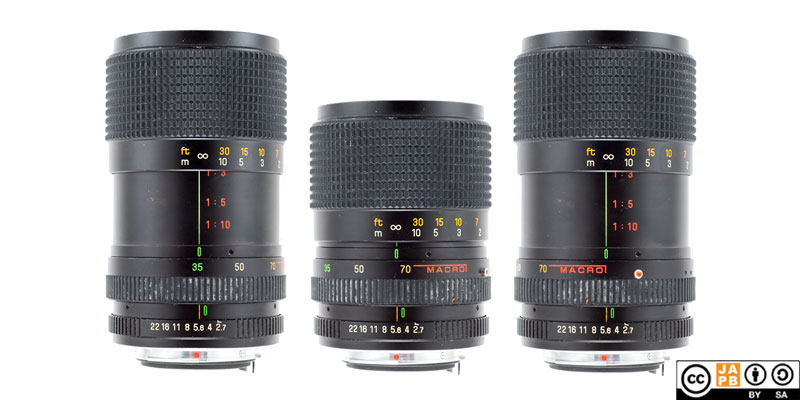Pekka Buttler, 02/2025

Specifications
The table below summarises the lens’ key specifications (measurements based on pictured sample):
| Brand: | Chinon | Lens name | Auto Zoom MC 35–70mm 1:2.7–3.5 |
| Focal length range1 | 35–70 mm | Angle-of-view2 | 63.4–34.3 ° |
| Maximum Aperture | f/2.7–3.5 | In Production | 1980s3 |
| Lens mount | Pentax K | Subfamily (if applicable) | –– |
| Length4 | 85,1 mm | Diameter5 | 65,3 mm |
| Filter ring diameter | 58 mm | Weight | 442 grams |
| Lens element count | 7 | Lens group count | 7 |
| Aperture blades (S/R/C)6 | 8 S | Focus throw | 180 ° |
| Minimum focusing distance (measured) | 78 cm@35mm; 67 cm@70mm; 25 cm@macro mode | Maximum magnification (measured) | 1:9,7 (@70 mm) 1:2,4 (macro mode) |
| Has manual aperture ring | YES | Has Manual focus ring | YES |
| Aperture mechanism type | Automatic | Aperture click stops7 | 2.7-4-5.6-8-11-16-22 |
Further notes:
• This standard zoom has rather ambitious specifications. While it does not offer a constant maximum aperture (a hallmark of a pro zoom lens), it does offer an exceptionally bright maximum aperture.
• It is a two-ring zoom with the front ring controlling focus and the rear ring controlling focal length (zoom).
• The lens changes shape considerably when zooming. The lens is at its longest at the 35 mm setting, and shortest at the 70 mm setting. The overall zoom extension is ≈20 millimetres.
• Furthermore the lens changes length when focusing and the focus extension is another ≈8 millimetres.
• The filter threads rotate when focusing.
• This lens offers a semi-decent minimum focusing distance for a legacy zoom lens. That the lens furthermore offers a macro mode which allows a maximum magnification of 1:2,4 makes this lens a strong contended for the title of ultimate all-rounder.

Middle: Chinon Auto Zoom MC 35-70mm f/2.7–3.5 @ 70mm
Right: Chinon Auto Zoom MC 35-70mm f/2.7–3.5 in macro mode
Versions and origins
There seems to be only one cosmetic version of the Chinon Auto Zoom MC 35-70mm f/2.7–3.5 lens. Boring.
However, in terms of origins it gets a bit interesting.
Chinon did not manufacture its own lenses (Chinon focused on camera manufacture), instead sourcing its lenses from various Japanese lens manufacturers, ranging from small manufacturers few have ever heard about to well-known (and -respected) companies such as Tomioka.
Often it is possible to – through the sleuthwork of comparing a Chinon lens to other lenses – deduce something about the likely manufacturers. However, in this case this is made difficult by that there are no other Japanese lenses that even share the same mainline specifications of a 35–70 zoom range in combination with the rather unusual maximum aperture of f/2.7–3.5.
There is however one contemporary lens that shares the exactly same mainline specifications and that’s the Carl Zeiss Jena Vario-Prakticar/Vario-Pancolar 35-70/2.7-3.5 [data sheet]. Moreover both lenses are outwardly somewhat similar and both lenses have a button-activated macro mode beyond the 70 mm setting. And Carl Zeiss Jena was known to sometimes license its designs to Japanese manufacturers. This has led to some speculation online that the lowly Chinon might in fact be a shortcut to a rather prestigious Carl Zeiss Jena design.
Owning both lenses I can unequivocally say that this Chinon is NOT a rebrand of the Carl Zeiss Jena Vario-Prakticar/Vario-Pancolar 35-70/2.7-3.5 (see the details on why not in this JAPB article). However, I cannot entirely refute that some level of inspiration might have taken place (given the commonalities, I would think that whichever Japanese lens manufacturer designed this Chinon 35-70/2.7-3.5 probably drew more than a little inspiration from the Jena product).
Alas, unless one of my well-informed readers can effectively enlighten me, we will have to accept that the origin story of this Chinon lens will not be uncovered here.
Chinon company profile
Chinon is known to still photographers as one of the more advanced 2nd tier Japanese cameramakers. From 1971 to the late 1980s Chinon was known to enthusiast photographers the world over for combining technological advancements in cost-effective cameras bodies. See more details in the Chinon company profile.
Adapting
n.B! The following applies to all non-electronic Pentax K mount lenses.
If you want to natively mount this lens you need to find a functioning Pentax K mount SLR (or a dSLR) camera. Luckily that should be relatively easy as Pentax K film bodies were produced in their millions and most of them – especially those manufactured by Pentax – have a good reliability record. Alternatively, you can use this lens natively on any Pentax dSLR.
Adapting this lens to a mirrorless, full-frame digital camera is a breeze thanks to the lens having full manual controls (aperture ring, focus ring). You simply need a dumb adapter from Pentax K to your mirrorless system.
Due to the medium flange focal distance used by the m42 mount (45,46 mm), whether you can adapt this lens to other than Pentax’ dSLR mounts depends on which dSLR mount: Canon EF, and Four Thirds can mount Pentax K lenses using a simple adapter ring. Minolta/Sony A and Nikon F on the other hand are not as problem-free, and – to retain anything near infinity focus – the adapter will necessitate corrective optics. In all cases, your camera will work only in stop-down metering.
Footnotes
- Focal length is (unless stated otherwise) given in absolute terms (not in Full-frame equivalent), and according to the manufacturer’s naming practice (which does not always reflect the lens’ actual field of view). For an understanding of whether the lens is wide/tele, see ‘Angle-of-view’. ↩︎
- Picture angle is given in degrees and concerns the diagonal picture angle. Rule of thumb:
> 90 ° ==> Ultra-wide-angle
70–90 ° ==> Wide-angle
50–70 ° ==> Moderate wide-angle
40–50 ° ==> ‘Standard’ or ‘normal’ lens
20–40 ° ==> Short tele lens
10-20 ° ==> Tele lens
5-10 ° ==> Long tele lens
< 5 ° ==> Ultra-tele lens ↩︎ - Documentation (e.g. brochures) of Chinon lenses are scarce and manuals are of no help in trying to date Chinon lenses as pictures in manuals surprisingly often show lenses that differ from those that were actually produced. Hence, dating these lenses is surprisingly difficult. ↩︎
- Length is given from the mount flange to the front of lens at infinity. Measured unless stated otherwise. ↩︎
- Diameter excludes protrusions such as rabbit ears or stop-down levers. Measured unless stated otherwise. ↩︎
- S=straight; R=rounded; C=(almost)circular at all apertures. ↩︎
- Numbers equal aperture values on aperture ring; • intermediate click; – no intermediate click. ↩︎
Since there were not enough production capacities (or capabilities) at Carl Zeiss Jena (East Germany) where the lens could have been produced, Zeiss-East sold the construction to a “Japanese Company” as I was told around 1983. Whether Zeiss-East has participated financially in sales results of this “Japanese Company”, I don’t know.
I am in possession of both lenses (even 3 copies of the Jena original), and it can – from my point of view – clearly been stated that the East German version performs much better in regard to optical results.
As far as I know, there is not any lens existing on earth – with the aperture range “2.7-3.5”, from no manufacturer. Correct me, if I am wrong.
Hi Albert,
You’re right in that the 2.7–3.5 maximum aperture range is rare. In doing my research for the JAPB follow-up article “The Chinon 35–70/2.7–3.5 is not a Carl Zeiss Jena lens in disguise (or vice versa).” I tried to scour all imaginable databases for a similar spec design, and found only the two: the Carl Zeiss Jena Vario-Pancolar/Prakticar and the Chinon.
Given the clear differences in construction and IQ, I have a rather hard time seeing the exact form of the relationship.
• Yes, it is true that the East German still camera industry developed only two domestic zoom designs (the CZJ 35-70/2.7-3.5 [data sheet] and the CZJ 80-200/4 [data sheet]) and that the price of these was so high that they sold badly in the domestic markets and hence are rather rare. Looking at detailed articles on the development of these lenses it seems they were as over-engineered as only German engineers know how, and likely never developed for economical manufacture.
• Yes, it is true that the East German camera industry in the 80s increasingly had to rely on selling Japanese and Korean lenses rebranded as Pentacon/Prakticar lenses, partially because of how many 3rd party manufacturers in these countries had perfected the art of making lenses for every conceivable price point.
• Hence, it could be imagined that CZJ handed the design over to some of those Japanese/Korean companies with the remit of “see if you can make this design more economical” and that this is the starting point that led to the Chinon 35-70/2.7-3.5…
• Whatever company received this assignment could then have started reconfiguring the lens, cutting down the number of lens elements, using less elaborate glass mixtures, rearranging the moving parts to simplify the mechanics, use more cost-effective coatings, etc. – all the things you’d normally do to press down costs. In such a case it would be natural that the lens would become bigger (the Chinon is), heavier (the Chinon is) and have more IQ compromises (the Chinon does).
• This would indeed be a plausible explanation for the relationship, but there is one thing that bothers me about it: Making so radical changes in the optical recipe (from 9 elements in 8 groups to 7 elements in 7 groups with more mundane glass sorts) while keeping the same focus length range; the same maximum aperture range; and the same basic functionality (two ring zoom with macro at 70 mm) seems like jumping through the most demanding hoops when cost savings could more easily have been achieved by making even minor concessions in the maximum aperture.
Alas, we can speculate all we want, but we might never know for sure.